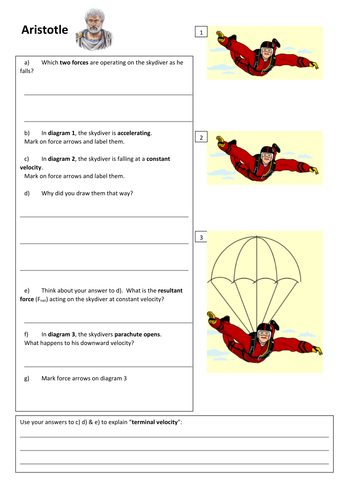





A GCSE Physics lesson on terminal velocity with differentiated worksheets and practical activity (will need equipment) based on a class of 24 pupils in 4 groups. It's busy, mucky, and, like all good physics lessons, they've got to work stuff out.
MUST:
Identify forces on a falling object in a fluid
SHOULD:
Use force diagrams to show how force changes during a fall/describe changes
COULD:
Explain terminal velocity/in terms of resultant force/Interpret v/t graphs
Powerpoint is to provide structure to the lesson and includes the plenary. I recommend embedding the online stopwatch.
Starter – individual (Grade C) entry question based on previous lessons
Task 1: Experiment – groups, roles in groups, (calculations v=d/t + mean) B- A grade
Task 2: Group 4 – Aristotle worksheet (B grade) – less wordy task
Group 3 – Galileo worksheet (B to A grade) – task includes acceleration calculations
Group 2 & 1 – Newton worksheet (A grade) – focuses on graphs only
Plenary Exam question – individual, self-assess.
MUST:
Identify forces on a falling object in a fluid
SHOULD:
Use force diagrams to show how force changes during a fall/describe changes
COULD:
Explain terminal velocity/in terms of resultant force/Interpret v/t graphs
Powerpoint is to provide structure to the lesson and includes the plenary. I recommend embedding the online stopwatch.
Starter – individual (Grade C) entry question based on previous lessons
Task 1: Experiment – groups, roles in groups, (calculations v=d/t + mean) B- A grade
Task 2: Group 4 – Aristotle worksheet (B grade) – less wordy task
Group 3 – Galileo worksheet (B to A grade) – task includes acceleration calculations
Group 2 & 1 – Newton worksheet (A grade) – focuses on graphs only
Plenary Exam question – individual, self-assess.
Something went wrong, please try again later.
This resource hasn't been reviewed yet
To ensure quality for our reviews, only customers who have purchased this resource can review it
Report this resourceto let us know if it violates our terms and conditions.
Our customer service team will review your report and will be in touch.
£3.00